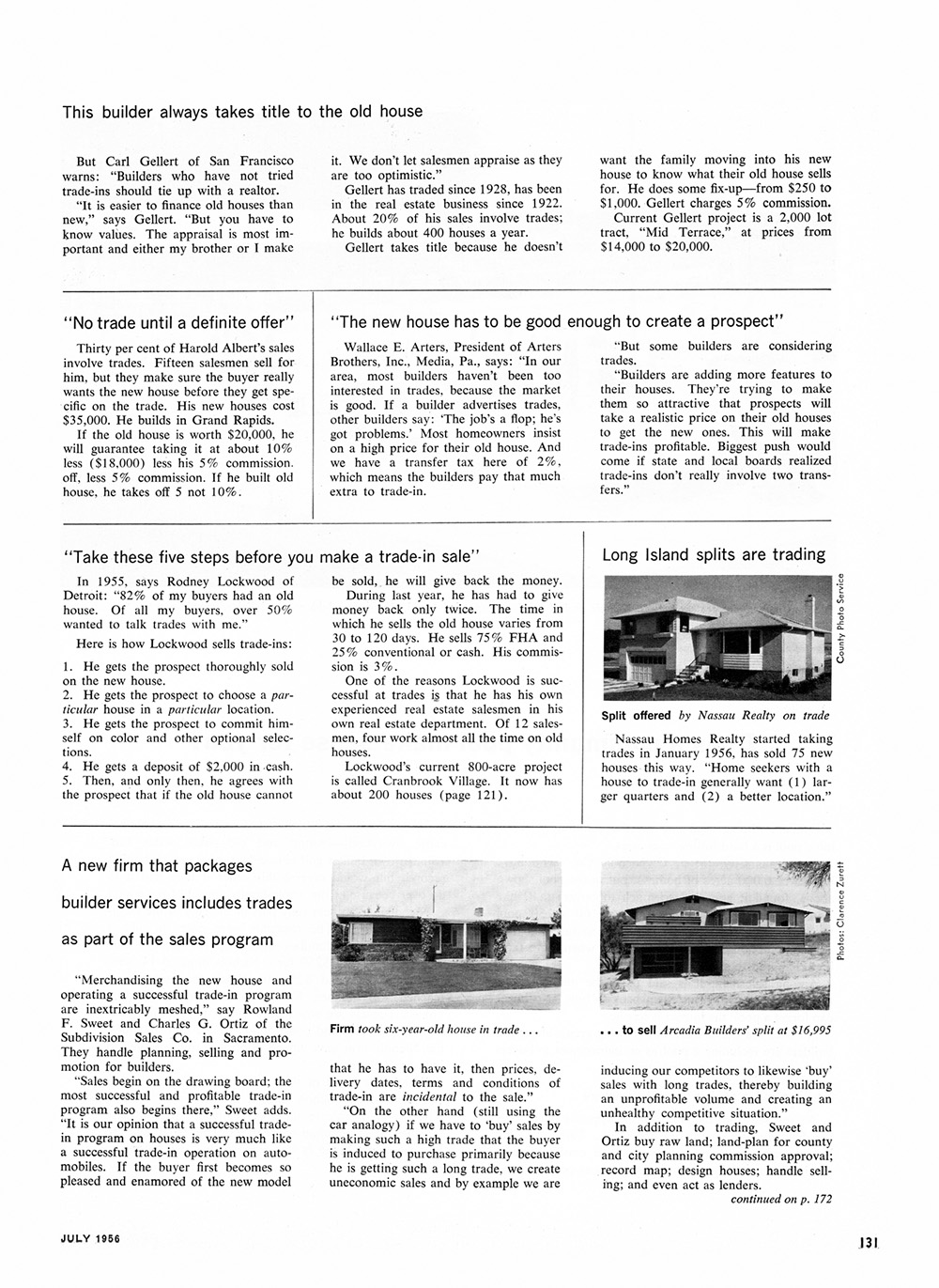


This builder always takes title to the old house
But Carl Gellert of San Francisco warns: "Builders who have not tried trade-ins should tie up with a realtor.
"It is easier to finance old houses than new," says Gellert. "But you have to know values. The appraisal is most important and either my brother or I make
it. We don't let salesmen appraise as they are too optimistic."
Gellert has traded since 1928, has been in the real estate business since 1922. About 20% of his sales involve trades; he builds about 400 houses a year. Gellert takes title because he doesn't
want the family moving into his new house to know what their old house sells for. He does some fix-up from $250 to $1,000. Gellert charges 5% commission.
Current Gellert project is a 2,000 lot tract, "Mid Terrace," at prices from $14,000 to $20,000.
"The new house has to be good enough to create a prospect"
"No trade until a definite offer"
Thirty per cent of Harold Albert's sales involve trades. Fifteen salesmen sell for him, but they make sure the buyer really wants the new house before they get specific on the trade. His new houses cost $35,000. He builds in Grand Rapids.
If the old house is worth $20,000, he will guarantee taking it at about 10% less ($18,000) less his 5% commission, off, less 5% commission. If he built old house, he takes off 5 not 10%.
In 1955, says Rodney Lockwood of Detroit: "82% of my buyers had an old house. Of all my buyers, over 50% wanted to talk trades with me."
Here is how Lockwood sells trade-ins:
1. He gets the prospect thoroughly sold on the new house.
2. He gets the prospect to choose a particular house in a particular location.
3. He gets the prospect to commit himself on color and other optional selections.
4. He gets a deposit of $2,000 in cash.
5. Then, and only then, he agrees with the prospect that if the old house cannot
Wallace E. Arters, President of Arters Brothers, Inc., Media, Pa., says: "In our area, most builders haven't been too interested in trades, because the market is good. If a builder advertises trades, other builders say: "The job's a flop; he's got problems.' Most homeowners insist on a high price for their old house. And we have a transfer tax here of 2%, which means the builders pay that much extra to trade-in.
be sold, he will give back the money.
During last year, he has had to give money back only twice. The time in which he sells the old house varies from 30 to 120 days. He sells 75% FHA and 25% conventional or cash. His commission is 3%.
One of the reasons Lockwood is successful at trades β that he has his own experienced real estate salesmen in his own real estate department. Of 12 salesmen, four work almost all the time on old houses.
Lockwood's current 800-acre project is called Cranbrook Village. It now has about 200 houses (page 121).
"But some builders are considering trades.
"Builders are adding more features to their houses. They're trying to make them so attractive that prospects will take a realistic price on their old houses to get the new ones. This will make trade-ins profitable. Biggest push would come if state and local boards realized trade-ins don't really involve two transfers."
Long Island splits are trading
Split offered by Nassau Realty on trade
Nassau Homes Realty started taking trades in January 1956, has sold 75 new houses this way. "Home seekers with a house to trade-in generally want (1) larger quarters and (2) a better location."
"Take these five steps before you make a trade-in sale"
A new firm that packages builder services includes trades as part of the sales program
"Merchandising the new house and operating a successful trade-in program are inextricably meshed," say Rowland F. Sweet and Charles G. Ortiz of the Subdivision Sales Co. in Sacramento. They handle planning, selling and promotion for builders.
"Sales begin on the drawing board; the most successful and profitable trade-in program also begins there," Sweet adds. "It is our opinion that a successful trade-in program on houses is very much like a successful trade-in operation on automobiles. If the buyer first becomes so pleased and enamored of the new model
Firm took six-year-old house in trade ...
that he has to have it, then prices, delivery dates, terms and conditions of trade-in are incidental to the sale."
"On the other hand (still using the car analogy) if we have to "buy' sales by making such a high trade that the buyer is induced to purchase primarily because he is getting such a long trade, we create uneconomic sales and by example we are
.. . to sell Arcadia Builders' split at $16,995
inducing our competitors to likewise "buy' sales with long trades, thereby building an unprofitable volume and creating an unhealthy competitive situation."
In addition to trading, Sweet and Ortiz buy raw land; land-plan for county and city planning commission approval; record map; design houses; handle selling; and even act as lenders.
continued on p. 172
Photos: Clarence Zurett County Photo Service